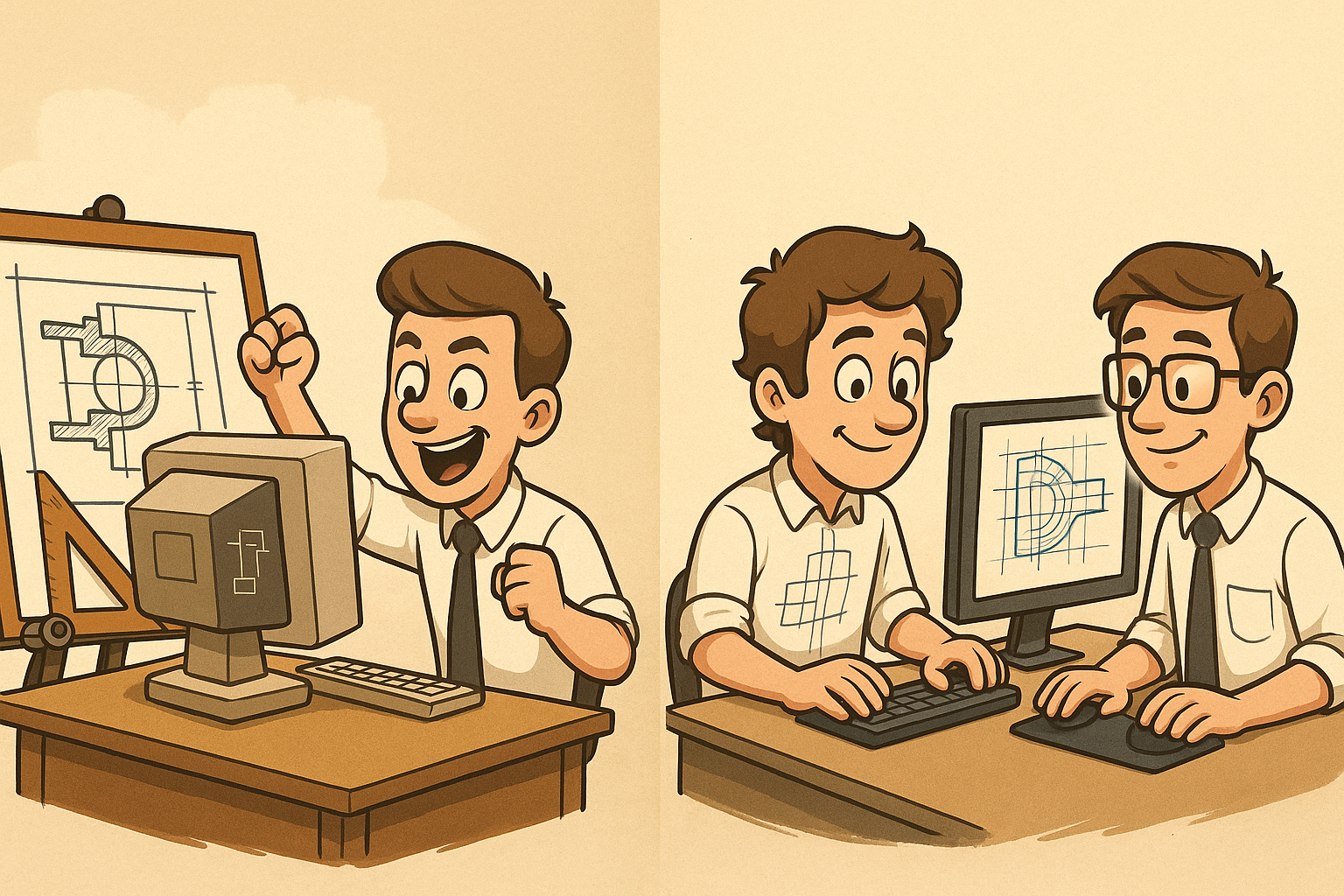Your Cart is Empty
Customer Testimonials
-
"Great customer service. The folks at Novedge were super helpful in navigating a somewhat complicated order including software upgrades and serial numbers in various stages of inactivity. They were friendly and helpful throughout the process.."
Ruben Ruckmark
"Quick & very helpful. We have been using Novedge for years and are very happy with their quick service when we need to make a purchase and excellent support resolving any issues."
Will Woodson
"Scott is the best. He reminds me about subscriptions dates, guides me in the correct direction for updates. He always responds promptly to me. He is literally the reason I continue to work with Novedge and will do so in the future."
Edward Mchugh
"Calvin Lok is “the man”. After my purchase of Sketchup 2021, he called me and provided step-by-step instructions to ease me through difficulties I was having with the setup of my new software."
Mike Borzage
Design Software History: The Evolution of Design Software: From Manual Drafting to Integrated Engineering Computation
October 03, 2025 10 min read


Introduction: Defining the Intersection
The convergence of design software and engineering computation has redefined modern design practices, bringing together the precision of computational analysis and the creative potential of computer-aided design. In the early days, the division between design and engineering was clear: designers hand-drew each blueprint with meticulous care, while engineers applied rigorous calculations manually. With the advent of digital technology in the later decades of the twentieth century, this distinction began to blur as computers emerged as indispensable tools in both creative design and technical analysis. The melding of these disciplines has spawned integrated systems that not only capture the aesthetic nuances of a design but also simulate real-world behavior through advanced computational methods. This process integrates tools such as CAD (Computer-Aided Design) and CAE (Computer-Aided Engineering) to create platforms where simulation and analysis are conducted in tandem with design creation. Sophisticated computational techniques, including simulation and finite element analysis (FEA), allow engineers to predict how a product will perform under various conditions, leading to more efficient design cycles and reduced prototyping costs. The overlap of design creativity and engineering rigor has, over time, contributed to innovations that have transformed multiple industries by enabling highly iterative and precise workflows.
Foundational Terminology and Concepts
In exploring this integrated domain, it is essential to clarify the key terminology that underpins modern design practices. Terms such as CAD, which refers to the computer-assisted creation of product models, and CAE, which is dedicated to the simulation and analysis of these models, are central to understanding the convergence. Additionally, the concept of simulation involves creating a digital twin of real-world conditions to predict the behavior of a design under stress, thermal changes, or dynamic loads, while finite element analysis provides the granular computational method to dissect complex structures into manageable elements for precise evaluation. Underneath these definitions lies a powerful evolution in software tools that seamlessly integrate visual creativity with analytical precision. This integration helps to bridge the gap between initial concept and final product, ensuring that aesthetic ambitions are underpinned by technical stability and performance optimization. Over time, the evolution of this terminology has paralleled the sophistication of the software systems themselves, marking a significant milestone in design history.
The Significance of Convergence in Design History
What makes the convergence of design software and engineering computation particularly significant is not merely the individual advancements in digital tools and analysis algorithms but the way these elements now operate synergistically. This coalescence has fundamentally altered how designers and engineers approach their work. With the infusion of computational analysis into the design phase, iterations can be made quickly and efficiently, ensuring that each modification is validated against rigorous performance criteria. As a result, industries have experienced a dramatic reduction in cycle times while simultaneously achieving higher standards of quality and innovation. This integrated approach has allowed companies to explore complex geometries and refined structural details that would have been impractical or impossible with manual methods. In today’s landscape, where products are expected to excel in both functionality and aesthetics, the union of creative design and computational analysis is indispensable. The historical journey to this convergence reflects decades of iterative development and innovation, underscoring its vital role in shaping modern design workflows.
Historical Evolution and Key Pioneers
The historical evolution of design software is a rich tapestry of breakthroughs that have redefined how designers and engineers collaborate. In its earliest form, design was executed manually using drafting tools and extensive hand-drawn blueprints. These techniques, while effective, were time-consuming and often limited by human error. As computational technology emerged, the need for precision and rapid iteration spurred the development of digital tools that could both supplement and eventually replace manual drafts. Over time, rudimentary computer algorithms evolved into highly sophisticated systems capable of three-dimensional modeling and real-time simulation. Pioneering work in this field laid the foundation for the modern integrated systems that unify aesthetic design and engineering analysis. The evolution has been punctuated by landmark innovations that not only improved efficiency but also created entirely new methods of conceptualizing and testing designs. Through continuous refinement and technological breakthroughs, the evolution of these tools has reshaped the engineering landscape and simultaneously influenced diverse industries ranging from automotive to architecture.
From Manual Drafting to Computer-Aided Design
The transition from manual drafting to computer-aided design signifies one of the most transformative shifts in design history. Initially, designers relied solely on hand-drawn renderings that demanded extensive labor and a high degree of skill. This labor-intensive process often limited the pace of innovation, as each iteration of a design had to be painstakingly recreated. The introduction of early computer systems in the mid-twentieth century, however, brought about a change that would render manual drafting almost obsolete. Early CAD systems dramatically reduced the time required to produce detailed drawings and allowed for quick, precise modifications. This newfound capability enabled designers to explore and refine complex geometries that were previously inaccessible through traditional methods. The advantages of computer-aided design were highlighted in several key areas:
- Time Efficiency: Rapid revisions and iterations significantly reduced overall development time.
- Precision: Advanced software minimized human error and ensured higher accuracy.
- Flexibility: The ability to quickly manipulate designs facilitated innovative solutions.
- Integration: Early on, CAD began incorporating simulation elements, setting the stage for future convergence.
Influential Figures and Companies in Design Software Evolution
Over the decades, several influential figures and pioneering companies have driven the evolution of design software from its nascent stages to its current state of advanced integration. A seminal breakthrough occurred with Ivan Sutherland’s development of Sketchpad, an early system that introduced the interactive use of graphics in design and laid the groundwork for subsequent CAD systems. Sutherland’s innovative work demonstrated that computers could be used not merely as calculation devices but as interactive tools capable of visualizing and manipulating complex design elements. Beyond individual trailblazers, companies such as Dassault Systèmes and Siemens have played critical roles in shaping the industry. Dassault Systèmes, with its flagship CATIA system, pioneered the integration of computer-aided design with sophisticated engineering simulations, enabling designers to seamlessly move from illustration to analysis. Siemens Digital Industries Software has similarly contributed by integrating computational methods directly into the design workflow, facilitating real-time feedback and iterative enhancement. The contributions of these pioneers have merged artistic creativity with engineering precision, propelling the design field into a new era where digital tools are as integral to the process as traditional craftsmanship.
Evolution from Simple Aids to Integrated Systems
The progression from simple design aids to fully integrated computational systems illustrates a natural evolution driven by relentless technological advancement and the growing complexity of design challenges. Early CAD programs, though revolutionary at the time, were limited in their capacity to simulate real-world phenomena. Over successive generations, these tools evolved to encompass a myriad of functions, including three-dimensional modeling, parametric design, and real-time simulation. This evolution transformed software from a basic drafting tool into a comprehensive design environment where multiple functions coexisted in a unified interface. The integration of simulation capabilities, particularly finite element analysis, allowed designers to evaluate their models under realistic conditions, predicting stress distributions, thermal effects, and aerodynamic responses before any physical prototype was built. The resultant synergy between design and computational analysis enhanced not only the quality and performance of the final product but also reduced the risk and cost associated with traditional prototyping. The evolution reflects a dynamic interplay between user demands and technological progress, with each new innovation offering additional layers of functionality that feed back into the design process.
Continuing Innovations and the Role of Adaptation
Over the last few decades, the development of design software has seen a continuous stream of innovations that have further polished the integration between artistic design and rigorous engineering computation. As computing power increased and software became more sophisticated, early adopters began to incorporate interactive design elements and real-time feedback mechanisms into their workflows. This period witnessed the maturation of digital environments where design modifications could be instantly simulated to verify structural, thermal, and dynamic responses. Emerging technologies such as high-resolution graphics rendering and advanced computational algorithms significantly elevated the potential of design software. These advancements allowed for the integration of parametric design, where changes in one part of a model automatically update related components, thus preserving consistency and coherence across complex assemblies. Furthermore, networked computing began to play a crucial role as design teams spread across different locations could collaborate on the same project simultaneously through cloud-based platforms. This adaptability not only accelerated project timelines but also fostered a culture of continuous improvement, where feedback from actual usage was quickly funneled back into iterative software enhancements. Contributors from academia and industry alike have ensured that these software tools remain at the forefront of technological innovation by constantly embracing new computational paradigms and methodologies.
The Convergence of Design Software and Engineering Computation
The evolution of design software has reached a point where engineering computation is no longer an adjunct but a core integrated component of the design process. Modern design platforms are now imbued with advanced mathematical algorithms that allow them to perform simulations and finite element analysis alongside traditional drafting tools. This integration empowers designers and engineers to evaluate the viability of their creations in real time, ensuring that conceptual aesthetics are balanced with structural integrity. The seamless embedding of simulation functionalities within these systems has not only accelerated the time-to-market but also provided unparalleled insights into material behavior, load distribution, and aerodynamic performance. More importantly, the use of sophisticated optimization algorithms has enhanced the precision of design calculations, leading to products that are both innovative and reliably engineered. The expanding role of computational analysis in design is a clear testament to the transformation from separate, sequential stages of development to a holistic, parallel process where creativity and technical accuracy coexist in perfect harmony.
Embedding Mathematical Models and Algorithmic Precision
At the heart of this convergence lies the intricate incorporation of mathematical models and advanced algorithms within the design software itself. Development teams have meticulously embedded computational methods that enable these platforms to simulate a wide array of real-world conditions—from thermal fluctuations and mechanical stresses to fluid dynamics and material deformations. This integration is predominantly accomplished through powerful modules that handle finite element analysis and real-time simulation. As designers modify their digital models, these embedded systems dynamically recalculate performance metrics, providing immediate feedback on structural integrity and operational efficiency. The benefits of such integration are numerous, including a dramatic reduction in the design cycle time and the ability to preemptively address potential issues before physical prototyping begins. Key features that exemplify this sophisticated integration include:
- Real-Time Analysis: Immediate simulation results allow for instant design adjustments.
- Algorithmic Optimization: Intelligent algorithms drive design enhancements by identifying optimal configurations.
- Integrated Simulation Modules: These modules provide a cohesive environment for both design and engineering analysis.
- Adaptive Learning: Modern systems increasingly leverage data feedback to refine simulations, ensuring that models remain robust under varied conditions.
Industry Impact and Technological Challenges
The integration of design software with engineering computation has had a profound impact on multiple industries, driving innovation and operational efficiency in ways previously unimagined. In the aerospace sector, the ability to simulate aerodynamic properties and structural stress in real time has led to the development of safer and more efficient aircraft. The automotive industry, too, has reaped significant benefits; engineers can now simulate crash scenarios, optimize material usage, and enhance fuel efficiency, all within a single, cohesive design environment. Similarly, the fields of architecture and civil engineering have benefited from the ability to model complex structures and forecast environmental interactions with unprecedented precision. Despite these remarkable advancements, the journey toward full integration was not without obstacles. Early systems struggled with limited processing power and software compatibility issues, and the complexity of integrating multiple simulation tools often led to bottlenecks in design processes. However, as computational power has grown exponentially and cloud-based solutions have emerged, many of these challenges have been mitigated. Continuous breakthroughs in algorithm optimization, data handling, and interface design have allowed modern design platforms to overcome these initial hurdles, setting the stage for even more advanced integrations in the future.
Emerging Trends in Computation-Driven Design
In recent years, the synthesis of design software and engineering computation has matured into a discipline that not only resolves historical challenges but also propels the industry toward groundbreaking innovations. One of the most prominent emerging trends is the adoption of cloud-based design platforms that facilitate global collaboration and real-time data sharing. These distributed computing environments harness vast processing capabilities, thus enabling the execution of complex simulations that were once restricted to high-performance in-house systems. In addition, the rise of artificial intelligence and machine learning within design software is ushering in a new era of optimization. Algorithms now possess the capacity to predict design failures, analyze vast datasets for performance trends, and even suggest improvements automatically, thereby streamlining the creative process. Furthermore, sustainability has become paramount, with modern tools incorporating simulations that evaluate environmental impact over a product’s entire lifecycle. This is particularly significant for industries like automotive and aerospace, where efficiency and reduced emissions are critical design parameters. Moreover, immersive technologies such as virtual reality (VR) and augmented reality (AR) are being integrated to provide designers with a tangible sense of scale and interaction, bridging the gap between the digital model and real-world application. Collectively, these trends hint at a future where design and computation are not just integrated but are dynamically evolving to meet the ever-growing demands of innovation and efficiency.
Conclusion
In conclusion, the journey from manual drafting and isolated design tools to the sophisticated integration of design software with engineering computation represents one of the most significant evolutions in the history of design. The convergence of creative design practices with rigorous computational analysis has redefined product development across a spectrum of industries. From the early innovations spearheaded by Ivan Sutherland’s Sketchpad to the advanced systems developed by leaders like Dassault Systèmes and Siemens Digital Industries, this evolution underscores the intrinsic value of melding aesthetics with technical precision. Today’s design workflows, which integrate simulation, finite element analysis, and real-time data feedback, serve as living testaments to decades of technological advancement and cross-disciplinary collaboration. The benefits are manifold: reduced prototyping costs, accelerated development cycles, enhanced product performance, and a holistic approach to design that emphasizes both form and function. This historical context not only illustrates past achievements but also illuminates the path toward future innovations in the realm of design and engineering.
Looking Ahead: The Future of Integrated Design and Computation
As design software continues its dynamic evolution, the integration of engineering computation is set to become even more pervasive and transformative. Looking to the future, advancements in user interfaces, augmented reality, and cloud integration will further democratize access to high-powered design tools. These trends will empower a broader range of professionals to harness cutting-edge computational methods in crafting innovative, sustainable products. Moreover, the convergence of big data analytics and the Internet of Things (IoT) will bring forth a new generation of design systems capable of assimilating real-time performance feedback and environmental data. This integration will allow for continuous refinement of design choices throughout a product’s lifecycle, ensuring that modern innovations are both resilient and adaptive. Additionally, as multidisciplinary collaboration becomes more entrenched in the fabric of design practices, the synergy between creative insight and analytical precision will deepen, paving the way for solutions that are as robust as they are aesthetically compelling. In essence, the future of integrated design lies in a harmonious blend of human ingenuity and computational power—a blend that will undoubtedly drive innovation in aerospace, automotive, architecture, and beyond. As we embrace these emerging trends, it remains critical to reflect on the historical milestones that have led to this point, understanding that every breakthrough in integration has been a stepping stone toward an era where design is seamlessly synchronized with engineering computation.
Also in Design News

Rhino 3D Tip: Optimizing Viewports in Rhino 3D for Enhanced Modeling and Presentation
October 03, 2025 3 min read
Read More
Enhancing Design Handover with Integrated Documentation Tools for Seamless Collaboration and Innovation
October 03, 2025 9 min read
Read More
Cinema 4D Tip: Streamlining Model Exchange in Cinema 4D for Enhanced Workflow Efficiency
October 03, 2025 3 min read
Read MoreSubscribe
Sign up to get the latest on sales, new releases and more …


